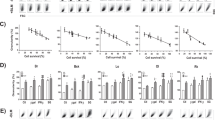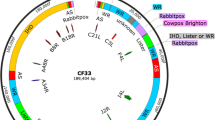Abstract
The time course of cytotoxicity induction and the bystander effect of the rabbit cytochrome P450 4B1 (cyp4B1)/4-ipomeanol (4-IM) or 2-aminoanthracene (2-AA) pharmacogene therapy systems were investigated and compared with the herpes simplex virus type 1 thymidine kinase/ganciclovir (HSV-tk/GCV) system. Experiments were performed in rat 9L gliosarcoma cells stably expressing cyp4B1 (9L-4B1), HSV-tk (9L-tk), or their egfp (enhanced green fluorescent protein) fusion genes. Cyp4B1-mediated activation of 2-AA showed a high cell killing efficiency within only 48 hours with an onset after already 15 minutes of prodrug exposure. Residual 9L-4B1 cells were mostly damaged sublethally upon 2-AA treatment showing an S phase arrest by cell cycle analysis. 4-IM treatment of 9L-4B1 cells generated an overall weaker cell killing, especially after prodrug exposure times of less than 48 hours. Residual cells surviving 4-IM treatment showed a G2/M arrest and restarted proliferation after prodrug treatment was stopped. HSV-tk/GCV pharmacogene therapy resulted in a slower cytotoxicity induction than cyp4B1/2-AA treatment with a significantly lower cell killing efficiency after 24 and 48 hours. HSV-tk/GCV–mediated cytotoxicity was widely similar to the cytotoxicity induced by cyp4B1/4-IM with the exception of a continuous 48-hour prodrug exposure where 4-IM treatment showed a significantly higher cell killing rate. Cells surviving HSV-tk/GCV suicide gene therapy were not viable and showed an S-phase arrest. Whereas HSV-tk/GCV induced a strong bystander effect, only moderate bystander cell death depending on cell-to-cell contact was demonstrated in 9L/9L-4B1 cocultures upon 2-AA treatment and was even absent with 4-IM, thereby contrasting with earlier reports. The absence of a strong bystander effect may limit, on one hand, the overall utility of the cyp4B1 systems for cancer gene therapy. On the other hand, the weak bystander effect together with the fast induction of cytotoxicity may provide marked advantages for the use of the cyp4B1 systems as biosafety enhancers for gene marking or replacement studies and donor lymphocyte infusions after allogeneic bone marrow transplantation.
This is a preview of subscription content, access via your institution
Access options
Subscribe to this journal
Receive 12 print issues and online access
$259.00 per year
only $21.58 per issue
Buy this article
- Purchase on Springer Link
- Instant access to full article PDF
Prices may be subject to local taxes which are calculated during checkout






Similar content being viewed by others
References
Moolten FL . Tumor chemosensitivity conferred by inserted herpes thymidine kinase genes: paradigm for a prospective cancer control strategy Cancer Res 1986 46: 5276–5281
Kramm CM, Sena-Esteves M, Barnett FH et al. Gene therapy for brain tumors Brain Pathol 1995 5: 345–381
Ram Z, Culver KW, Oshiro EM et al. Therapy of malignant brain tumors by intratumoral implantation of retroviral vector-producing cells Nat Med 1997 3: 1354–1361
Culver KW, Ram Z, Wallbridge S et al. In vivo gene transfer with retroviral vector–producer cells for treatment of experimental brain tumors Science 1992 256: 1550–1552
Takamiya Y, Short MP, Moolten FL et al. An experimental model of retrovirus gene therapy for malignant brain tumors J Neurosurg 1993 79: 104–110
Freeman SM, Abboud CN, Whartenby KA et al. The “bystander effect”: tumor regression when a fraction of the tumor mass is genetically modified Cancer Res 1993 53: 5274–5283
Barba D, Hardin J, Sadelain M et al. Development of anti-tumor immunity following thymidine kinase–mediated killing of experimental brain tumors Proc Natl Acad Sci USA 1994 91: 4348–4352
Rainov NG, Dobberstein KU, Sena-Esteves M et al. New prodrug activation gene therapy for cancer using cytochrome P450 4B1 and 2-aminoanthracene/4-ipomeanol Hum Gene Ther 1998 9: 1261–1273
Rainov NG, Sena-Esteves M, Fraefel C et al. A chimeric fusion protein of cytochrome CYP4B1 and green fluorescent protein for detection of pro-drug–activating gene delivery and for gene therapy in malignant glioma Adv Exp Med Biol 1998 451: 393–403
Steffens S, Frank S, Fischer U et al. Enhanced green fluorescent protein fusion proteins of herpes simplex virus type 1 thymidine kinase and cytochrome P450 4B1: applications for prodrug-activating gene therapy Cancer Gene Ther 2000 7: 806–812
Czerwinski M, McLemore TL, Philpot RM et al. Metabolic activation of 4-ipomeanol by complementary DNA-expressed human cytochromes P-450: evidence for species-specific metabolism Cancer Res 1991 51: 4636–4638
Verschoyle RD, Philpot RM, Wolf CR et al. CYP4B1 activates 4-ipomeanol in rat lung Toxicol Appl Pharmacol 1993 123: 193–198
Smith PB, Tiano HF, Nesnow S et al. 4-Ipomeanol and 2-aminoanthracene cytotoxicity in C3H/10T1/2 cells expressing rabbit cytochrome P450 4B1 Biochem Pharmacol 1995 50: 1567–1575
Weizsaecker M, Deen DF, Rosenblum ML et al. The 9L rat brain tumor: description and application of an animal model J Neurol 1981 224: 183–192
Zimmer C, Wright SC Jr, Engelhardt RT et al. Tumor cell endocytosis imaging facilitates delineation of the glioma–brain interface Exp Neurol 1997 143: 61–6916
Elion GB . The biochemistry and mechanism of action of acyclovir J Antimicrob Chemother 1983 12: Suppl. B 9–17
Reid R, Mar EC, Huang ES et al. Insertion and extension of acyclic, dideoxy, and ara nucleotides by herpesviridae, human alpha and human beta polymerases. A unique inhibition mechanism for 9-(1,3-dihydroxy-2-propoxymethyl)guanine triphosphate J Biol Chem 1988 263: 3898–3904
Samejima Y, Meruelo D . “Bystander killing” induces apoptosis and is inhibited by forskolin Gene Ther 1995 2: 50–58
Kolberg R . The bystander effect in gene therapy: great, but how does it work? J NIH Res 1994 6: 62–65
Denning C, Pitt JD . Bystander effects of different enzyme–prodrug systems for cancer gene therapy depend on different pathways for intercellular transfer of toxic metabolites, a factor that will govern clinical choice of appropriate regimes Hum Gene Ther 1997 8: 1825–1835
Wei MX, Tamiya T, Chase M et al. Experimental tumor therapy in mice using the cyclophosphamide-activating cytochrome P450 2B1 gene Hum Gene Ther 1994 5: 969–978
Chen L, Waxman DJ . Intratumoral activation and enhanced chemotherapeutic effect of oxazaphosphorines following cytochrome P-450 gene transfer: development of a combined chemotherapy/cancer gene therapy strategy Cancer Res 1995 55: 581–589
Karle P, Renner M, Salmons B, Gunzburg WH . Necrotic, rather than apoptotic, cell death caused by cytochrome P450–activated ifosfamide Cancer Gene Ther 2001 8: 220–230
Wei MX, Tamiya T, Rhee RJ, Breakefield XO, Chiocca EA . Diffusable cytotoxic metabolites contribute to the in vitro bystander effect associated with the cyclophosphamide/cytochrome P450 2B1 cancer gene therapy paradigm Clin Cancer Res 1995 1: 1171–1177
Bordignon C, Bonini C, Verzeletti S et al. Transfer of the HSV-tk gene into donor peripheral blood lymphocytes for in vivo modulation of donor anti-tumor immunity after allogeneic bone marrow transplantation Hum Gene Ther 1995 6: 813–819
Bonini C, Ferrari G, Verzeletti S et al. HSV-TK gene transfer into donor lymphocytes for control of allogeneic graft-versus-leukemia Science 1997 276: 1719–1724
Verzeletti S, Bonini C, Marktel S et al. Herpes simplex virus thymidine kinase gene transfer for controlled graft-versus-host disease and graft-versus-leukemia: clinical follow-up and improved new vectors Hum Gene Ther 1998 9: 2243–2251
Tiberghien P, Cahn JY, Brion A et al. Use of donor T-lymphocytes expressing herpes simplex thymidine kinase in allogeneic bone marrow transplantation: a phase I–II study Hum Gene Ther 1997 8: 615–624
Kolb HJ, Schattenberg A, Goldman JM et al. Graft-versus-leukemia effect of donor lymphocyte transfusions in marrow grafted patients. European Group for Blood and Marrow Transplantation Working Party Chronic Leukemia Blood 1995 86: 2041–2050
Porter DL, Collins RH Jr, Hardy C et al. Treatment of relapsed leukemia after unrelated donor marrow transplantation with unrelated donor leukocyte infusions Blood 2000 95: 1214–1221
Dazzi F, Szydlo RM, Goldman JM . Donor lymphocyte infusions for relapse of chronic myeloid leukemia after allogeneic stem cell transplant: where we now stand Exp Hematol 1999 27: 1477–1486
Burt R, Drobyski W, Traynor A et al. Herpes simplex thymidine kinase (HStk) transgenic donor lymphocytes Bone Marrow Transplant 1999 24: 1043–1051
Tiberghien P, Reynolds CW, Keller J et al. Ganciclovir treatment of herpes simplex thymidine kinase–transduced primary T lymphocytes: an approach for specific in vivo donor T-cell depletion after bone marrow transplantation? Blood 1994 84: 1333–1341
Acknowledgements
This study was supported by grants from the BioRegio program of the German Ministry for Research and Technology (Forschungsverbund Somatische Gentherapie; FKZ 0311661/1402; Projects 6 and 7), the Elterninitiative Kinderkrebsklinik Duesseldorf, Novartis-Pharma, Nuremberg, Germany, the State of Saxony-Anhalt (2794A/0087H), and the Deutsche Forschungsgemeinschaft (DFG Kr 1711/1-1).
Author information
Authors and Affiliations
Corresponding author
Rights and permissions
About this article
Cite this article
Frank, S., Steffens, S., Fischer, U. et al. Differential cytotoxicity and bystander effect of the rabbit cytochrome P450 4B1 enzyme gene by two different prodrugs: Implications for pharmacogene therapy. Cancer Gene Ther 9, 178–188 (2002). https://doi.org/10.1038/sj.cgt.7700422
Received:
Published:
Issue Date:
DOI: https://doi.org/10.1038/sj.cgt.7700422



